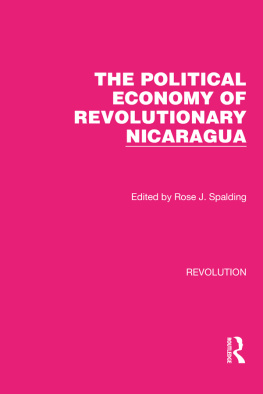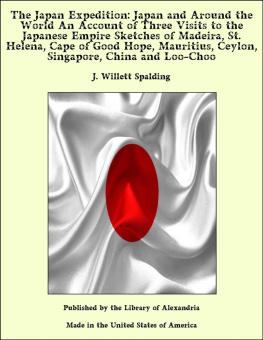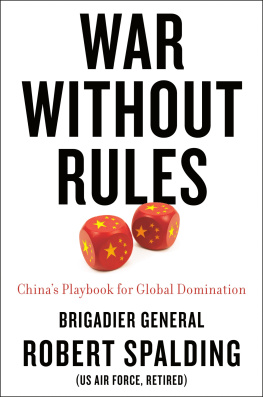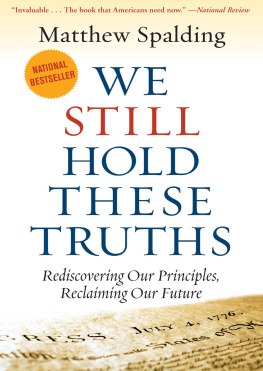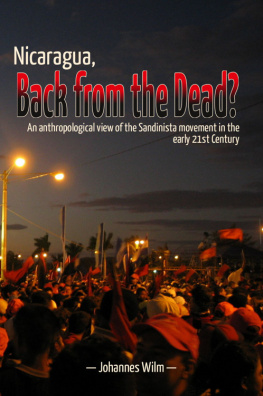Capitalists and Revolution in Nicaragua
1994 The University of North Carolina Press
All rights reserved
Manufactured in the United States of America
The paper in this book meets the guidelines for permanence and durability of the Committee on Production Guidelines for Book Longevity of the Council on Library Resources.
Spalding, Rose J.
Capitalists and revolution in Nicaragua : opposition and accommodation, 19791993 / Rose J. Spalding.
p. cm.
Includes bibliographical references (p. ) and index.
ISBN 0-80782150-0 (cloth : alk. paper).
ISBN 0-80784456-x (pbk. : alk. paper)
1. Business and politicsNicaragua. 2. Elite (Social sciences)Nicaragua. 3. NicaraguaPolitics and government 1979 . I. Title.
JL1609.5.B8S68 1994
322.3097285dc20 93-38430
CIP
98 97 96 95 94 5 4 3 2 1
tables
2.1. Financial System Loans to the Private Sector by Economic Activity, 19601979
2.2. Average Annual Real GDP Growth Rates in Central America
3.1. Projected Participation of Property Sectors in Agricultural Production
3.2. Land Distribution by Strata and Tenancy
3.3. Number of Properties and Area Affected in Agrarian Reform, 19811988
4.1. Sectoral Distribution of Long-Term Agricultural Credit, 19831988
5.1. Views on FSLN Government by Producer Strata
5.2. Views on FSLN Government by Educational Attainment
5.3. Views on FSLN Government by Where Educated
5.4. Views on FSLN Government by Private Sector Organization
5.5. Views on FSLN Government by Leadership Level
5.6. Views on FSLN Government by Expropriation Experience
5.7. Investment Level by Views on FSLN Government
5.8. Level of Production Change by Views on FSLN Government
6.1. Privatization of State Enterprises, May 1990-March 1993
6.2. State Farm Land Distribution Program, 1991
7.1. Configuration of State-Capital Characteristics and Bargaining Tendencies
A.l. Agricultural Production by Crop, 1974/751987/88
A.2. UNAG Membership Data, 1987
A.3. Nicaragua Economic Indicators, 19781992
A.4. Strata Definitions
A.5. UPANIC Membership and Landholding Data, 1985
preface
RAMIRO GURDIN Ortiz was an up-and-coming banana producer from an elite Len family when the Sandinista revolution occurred. On a farm his father carved out of the jungle, Gurdin had built up one of Nicaraguas larger banana plantations and was moving rapidly up the administrative ladder of Standard Fruits Nicaragua operation. He was skeptical of the insurrection that swept the regime of Anastasio Somoza Debayle from power in 1979 and brought in the leaders of the FSLN, and he remained aloof from the political imbroglio that followed. But in 1980, Jorge Salazar, the president of his private sector association, the Nicaraguan Union of Agricultural and Livestock Producers (UPANIC), began organizing a counterrevolutionary expedition and was killed by state security forces during an arms transaction. Gurdin agreed to serve as his replacement in UPANIC. During the next ten years, he became one of the nations most outspoken critics of the Sandinista regime. He was arrested, convicted, and placed on probation for violating the censorship provisions of the 1982 National Emergency decree; his farm was confiscated without compensation; his family scattered, leaving him as the sole continuing resident of Nicaragua.
Ricardo Coronel Kautz was a part-time rancher and full-time administrator of the livestock enterprise owned by the regions largest sugar mill, the Ingenio San Antonio, prior to the revolution. Son of Jos Coronel Urtecho, a prominent Nicaraguan intellectual who had served as a diplomatic representative of the Somoza regime but became increasingly disaffected, and his muse, Maria Kautz, a Nicaraguan of German descent whose family had been dispossessed of its primary estate by the Somoza regime during World War II, Coronel had developed an abiding antipathy for the Somoza dynasty. As a top administrator of Nicaraguas most prominent agroindustrial complex, Coronel helped organize an underground political movement among the technical staff in support of the Sandinista insurrection. In 1977 he was named to the prestigious Los Doce, a group of twelve prominent business, religious, and intellectual leaders who lobbied for international political support for the Sandinista cause in the final years of the insurrection. When he returned to Nicaragua after Somozas departure, he was appointed a vice-minister of agriculture and agrarian reform. For eleven years, Coronel served in the Nicaraguan government, exercising considerable influence over the state farm sector and agricultural development policy throughout the Sandinista era.
These vignettes suggest the range of views held by Nicaraguan economic elites about the Sandinista revolution. The relationship between the revolutionary government and most of Nicaraguas traditional business elite was generally antagonistic. Yet during the same period, some endorsed the revolution and became active participants in the social transitions it produced. Others ranged in between, reaching a tenuous accommodation with the regime but retaining a critical distance.
Two broad questions shape this study. The first addresses the theoretical debate about the composition and segmentation of the bourgeoisie. This analysis explores the unity/division of the capitalist class as it interacts with other social sectors. The second focuses on the capacity of economic elites to participate in a process of social change. This discussion evaluates the capacity of the elites to contribute to or to impede equitable distribution and the collective development of the nation.
Structural analysis, which has provided the dominant theoretical and methodological framework in Latin American studies for the last two decades, typically assumes a high degree of class cohesion. According to this approach, capital has clear interests and needs defined by its structural position in the economy. The dominant class is found to use its resources to impose constraints on other actors, limiting the options for structural change. The state may attain a relative autonomy from the business sector, but this autonomy is ultimately limited by the structural dependence of the state on capital. Capital, therefore, is understood as an increasingly united, cohesive actor. To the extent that segmentation occurs within the bourgeoisie, one fraction tends to emerge as the dominant force and exercise direction over the others.
Because of the fundamental cohesion of the bourgeoisie alleged in this model, any notions of cross-class alliances between the underclass and elements of the bourgeoisie are seen as inherently flawed. The participation of capitalist partners in a reform coalition is seen as ultimately undermining the movement because they are expected to serve the long-run interests of the dominant fraction of their class. For any structural transformation to occur, this exploitative class must be removed from power.
Yet Popular Front struggles and many progressive electoral strategies have been premised on the assumption that movements for social change can draw on the energies of a range of class actors, including elements of a nationalist or progressive bourgeoisie. Both Social Democratic and Democratic Socialist coalitions have understood the necessity for a continually evolving class compromise involving a component of the private sector in their movement. Latin American Populist and Third World National Liberation movements have traditionally drawn on a multiclass coalition that, while limiting the redistributive impact of the outcome, also allows for the participation of economic elites who can insert themselves into the changing economic order.


